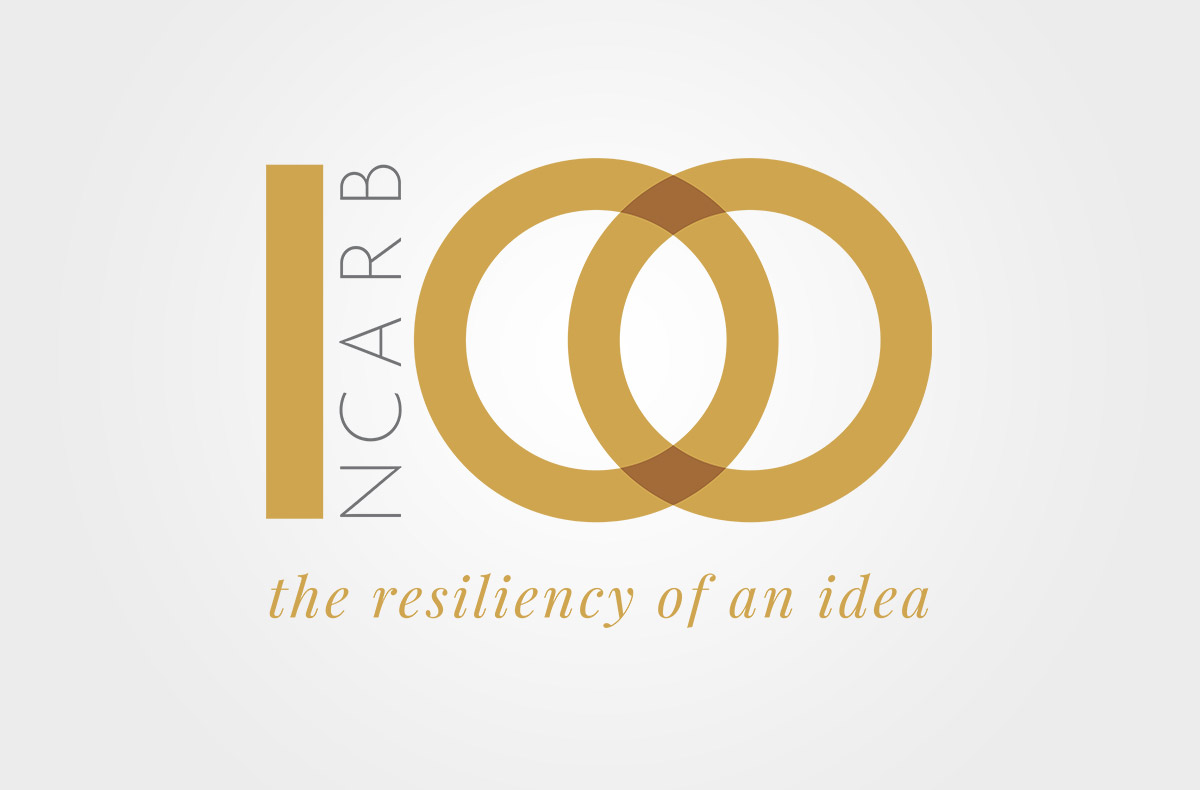For the past 100 years, NCARB has been the foundation of the architecture profession. As we celebrate our Centennial, we’re taking the time to celebrate our accomplishments, highlight important milestones, and dive deeper into the Council’s past, present, and future. NCARB has a rich history, and we're excited to share it with you.
DAVID L. HOFFMAN, FAIA
2019 NCARB PRESIDENT • KANSAS
1897
Illinois becomes the first state to regulate the profession of architecture.
1919
On May 2, 1919, 15 architects from 13 states gathered to discuss forming an organization to set standards for licensure and facilitate licensure between states. The result: NCARB is founded.
Founding Members: California, Colorado, Georgia, Illinois, Iowa, Kansas, Michigan, New York, North Carolina, Oregon, Pennsylvania, South Carolina, and Texas.
“At the time NCARB was formed, it had to be a challenge back then to bring those first organizations together and then to draw other state boards into the fold. That is the most transcendent accomplishment of NCARB. It’s unique, was very important to do, and it was very well done.”
“Heretofore, it has been those members of the profession which wished to establish a professional standard, looking toward public safety as well, that headed the movement toward securing such legislation. … [It] now appears that the movement is beginning to take its proper position as a demand from the people.”
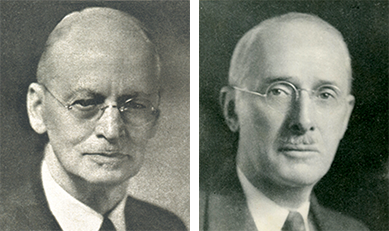
FOUNDING FATHERS
Emery Stanford Hall (Left), Emil Lorch (Right)
Did you know?
In 1922, only 27 percent of the country’s communities with over 5,000 people had any kind of building code.
“The Council is no longer an experiment. It is an established agency performing an effective work in a manner apparently satisfactory to its constituency.”
1920
Emil Lorch is elected NCARB’s first president.
The Council adopts its first constitution and bylaws.
1921
NCARB sets up shop in Emery Stanford Hall’s Chicago office. In the first year, the Council processed 45 applicants seeking reciprocal licensure.
“Many states do not have license laws for architects, but their necessity is being more universally recognized. It is but a question of time when all states will have registration laws for architects, and it is to be hoped that these laws will be uniform throughout the nation and not capable of many interpretations.”
1921
The first exams prepared by NCARB are given in Illinois to 19 architects—17 from Illinois and two from Iowa. There were two types of exams: the Standard Junior Exam for people seeking to get licensed and the Standard Senior Exam for architects who had been grandfathered into licensure wishing to practice in their states. All 19 applicants passed.
1922
NCARB members pass their first three resolutions, adding a past president position to the Board of Directors, approving the financial report, and approving a report from the Committee on Registration of Architects.
1930
32 jurisdictions have registration laws (30 states plus Hawaii and the Philippines).
1932
NCARB meets with the American Institute of Architects (AIA) Education Committee and the Association of Collegiate Schools of Architecture (ACSA) to discuss how the three organizations could work together. Representatives of AIA and ACSA were surprised at how much NCARB was able to accomplish in just over a decade.
“Mr. Hall stressed two chief questions to which the N.C.A.R.B. was struggling to find an answer. One was how to determine the list of accredited schools. The other was how to organize an internship for architects—a matter assuredly not so simple as in medicine. He added that the epitome of the Board's experience was that in 75 percent of cases, the first year's practical experience was wasted.”
1934
NCARB implements a mentorship program to match graduates with an architect to guide them through the type of experience needed to earn a license. The Great Depression and World War II prevent the program from gaining momentum.
“The profession is pleased to call itself a learned profession. If this assumption is to be supported, then it is paramount that broad and high standards of qualifications shall be maintained.”
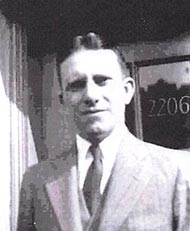
Did you know?
While NCARB had helped architects get licensed in multiple jurisdictions since 1921, it formalized its record keeping process in 1930. Record holder #1 was McDonald Lovell from Illinois who was issued a Record in April 1930. He used his Record to get licensed in Wisconsin and Indiana. He would eventually get NCARB certified in 1946, so he could get licensed in Texas.
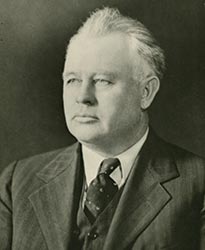
“A good many years ago we operated without anything, mostly in the red. We tried to carry on, and once in a while we would take up a little donation to help. In the thirties we just about gave up.”
Did you know?
Twenty schools were included in the first round of NAAB accreditations in 1945. The number had doubled by 1955, and more than tripled by 1965. Today, there are more than 150 programs accredited by the NAAB in over 130 institutions.
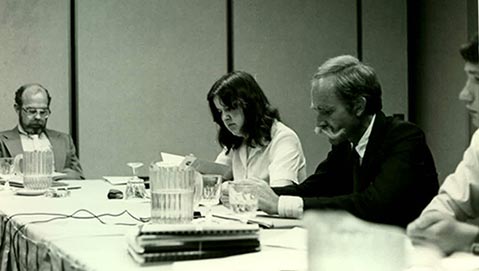
NCARB VOLUNTEERS
NCARB relies on the insight and knowledge of volunteers to develop its programs and initiatives—from architects to educators to public members.

THE FIRST OHIO STATE BOARD OF EXAMINERS OF ARCHITECTS FROM 1931
NCARB’s members are the boards of architecture in each jurisdiction. They are the bodies who issue licenses to practice architecture and are responsible for protecting the health, safety, and welfare of the public.
1938
NCARB formalizes its certification program. The first NCARB Certificate is issued to Nelson Spencer of Illinois.
1939
1938-39 NCARB President William Perkins of Iowa becomes NCARB’s secretary after the death of Emery Stanford Hall. As a result, the NCARB office moves to Chariton, Iowa.
1940
NCARB, AIA, and ACSA form the National Architectural Accrediting Board (NAAB) to handle accreditation of schools of architecture.
1942
NCARB creates a Board of Review to help the secretary handle planning Council meetings and reviewing appeals from applicants denied certification.
1945
NCARB releases its first newsletter.
“It seems obvious to me that the first step in the furtherance of any organization is a vigorous and vital publication.”
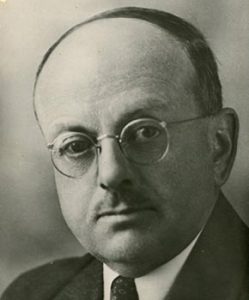
“There could be no better demonstration of the need for this Council than what it is accomplishing and the work it is doing in these difficult times of the war emergency. It has been of assistance not only to the public and to the architectural profession, but to the federal government in the endeavor to select the proper men for important war work.”
1955
NCARB members vote to have students record their experience in a log book as part of the “Architect-in-Training” program. Log books are poorly maintained and the program only lasts a couple of years.
1957
NCARB moves to Oklahoma City to be near First Vice President Joseph Smay of Oklahoma, who volunteered to take over the role of secretary after the death of William Perkins. Smay learns quickly how much work the position requires, and suggests the Council hire someone full-time to focus on running the Council.
James Sadler takes over as the first executive director who wasn’t a member of the Executive Committee of architect volunteers. By 1957, NCARB considers moving again, and decided to relocate to Washington, DC, to be close to other national architecture organizations.
1961
NCARB volunteers begin to convert its examination in to multiple-choice questions with the help of Education Testing Services (ETS) of Princeton, NJ.
“We gather around a table for two days, and often two nights, to go through, question by question, the raw material that has been prepared. The intent is to determine regional conflicts, refine question wording, and select those which will produce a final balanced exam.”
1964
NCARB Member Boards vote to officially form six regions: New England, Middle-Atlantic, Southern, Mid-Central, Central, and Western. Four were fully operational by 1966.
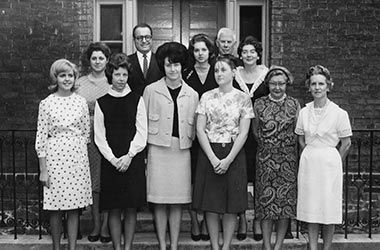
Did you know?
NCARB has called four cities home: Chicago (1919-1939); Chariton, IA (1939-1957); Oklahoma City (1957-1962); and Washington, DC (1963-Present).
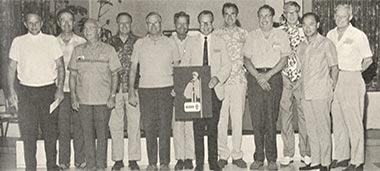
Did you know?
The NCARB Board of Directors expanded to include regional directors in 1968. The Board expanded again in 2008 to add a public member and member board executive. Both moves help add diversity to the Board—both in terms of overall make up and opinion.
NOTABLE FIRSTS
1968: WORLEY WONG
First Asian-American to serve on the Board
1979: LORENZO “PETE” WILLIAMS
First African-American president
1985: LAURA N. CRONENWETT
First woman to serve on the Board
1997: ANN R. CHAINTREUIL
First woman to serve as president
2008: AVA J. ABRAMOWITZ
First public member on the Board
2008: CYNTHIA J. MCKIM
First Member Board Executive on the Board

THE EXAMINATION
Developing and maintaining a national examination has required the work of hundreds of dedicated volunteers. Explore the ways the exam has evolved throughout NCARB’s history
1965
NCARB provides a national seven-part examination to its Member Boards. It incorporates multiple-choice questions and questions that required graphic responses.
1968
NCARB and the Architects Registration Council of the United Kingdom agree on a reciprocity arrangement. The agreement lasts until the 1980s.
Evolution of
Standards
1973
NCARB replaces the examination with the Professional Examination and the Equivalency Examination (later renamed to Qualifying Examination). The Equivalency exam was developed for candidates who did not have a degree from a NAAB-accredited program and the Professional was for those who did. The exams were not always administered as intended with some states requiring all candidates to take both.
1974
Iowa becomes the first state to require continuing education for license renewal.
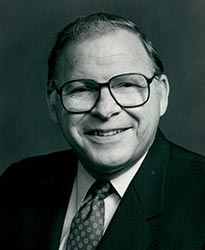
“The lack of enforcement of standards after licensure is no longer being tolerated by consumers, legislators and other regulatory bodies. They are asking that practitioners demonstrate their competence on a regular basis.”
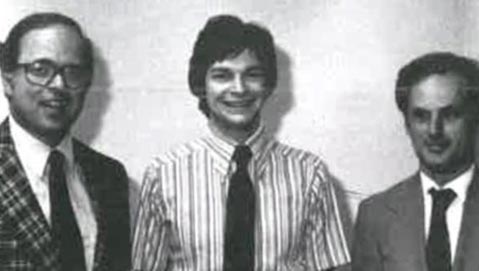
THE EXPERIENCE PROGRAM
The national experience program has gone through many iterations since its launch in 1977. Learn more about the way requirements have changed.
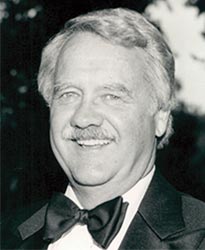
“If we are not uniform, consistent, fair, and honest, we flirt with the destruction of one of our finest achievements—reciprocity.”
1977
Following pilot programs in Texas, New Jersey, and Colorado, NCARB Member Boards vote to establish the Intern-Architect Development Program (IDP). A year later, Mississippi becomes the first state to require the IDP for licensure. In 1979, Dwight Dobberstein becomes the first person to complete the IDP.
1983
A new examination from NCARB launches, the Architect Registration Examination (ARE). The exam was taken over four consecutive days and took candidates 32.5 hours.
“I believe the ARE is one of the best exams we have ever prepared.”
1984
A professional degree from a NAAB-accredited program becomes a requirement for NCARB certification.
“I think it's important to note that we feel that the certification standard should be as close as possible to or equal to the highest standards set by the states. Many states are now requiring the five-year Bachelor of Architecture degrees and in light of this we feel that the certification process should bring itself up to at least a close level or the highest levels of the states.”
1988
The Council experiments with computer-based testing for the ARE. Field tests were completed between 1988-1991. The costs proved too high, and the Council decided to stay with pencil-and-paper testing for the time being.
Going Digital
1992
NCARB established the Architect Development Verification Program to offer continuing education.
1994
NCARB’s Member Boards approve the recognition agreement with Canada.
1996
This is a busy year for NCARB: the IDP becomes required for NCARB certification, Building Community (a report by Ernest Boyer and Lee Mitgang) is released, and the first NCARB website launches.
“The greatest positive aspect of the Boyer Study … is that it gives us a very effective tool to bring forward many of the things that we have been talking about for many years … that change might be expedited.”
Did you know?
The ARE was also used by Canada to license architects. Two provinces began using portions in 1986. By 1991 all provinces were using the exam and it was translated into French for Quebec in 1992. While still administered in Canada, the country launched their own exam in 2008.
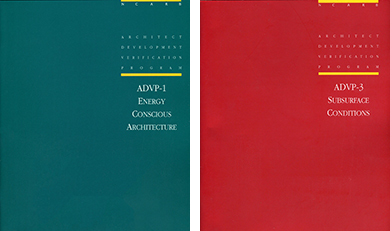
Did you know?
NCARB released its first monograph to help architects earn Health, Safety, and Welfare (HSW) continuing education credit in 1993. Energy Conscious Architecture was the first of over 25 titles that would be released over the next two decades.
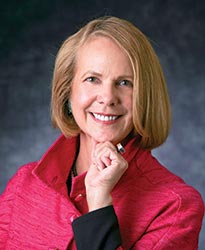
"One of the most significant ways NCARB assists you is the verification and exchange of credentials. Our challenge as we move forward in this century is how we mesh that system with others around the globe to ensure the public's well-being."
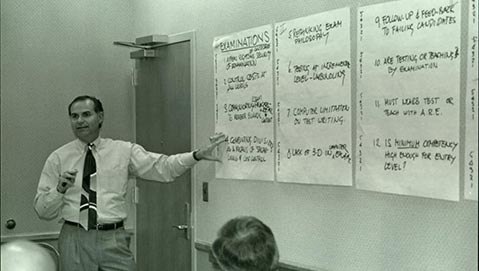
BLUE-SKY THINKING & STRATEGIC PLANNING
The Strategic Plan is an important part of the way NCARB sets and accomplishes goals, both long-term and short-term.
The [Architect Development Verification Program (ADVP)] is a program whereby a Member Board will have the mechanism to verify that the public health, safety, and welfare is being considered in the continuing education program.”
1997
The ARE moves to computer delivery. The exam becomes available year-round.
“The exams were written by the states at one time, and then it began being written by NCARB. The professionalism through which it was produced [and] the transformation to the computerized exam [should be huge points of pride for the Council.]”
1999
NCARB introduces its first Strategic Plan.
2001
NCARB implements the Broadly Experienced Architect (BEA) Program for architects without the degree from a NAAB-accredited program to earn the NCARB Certificate. To earn NCARB certification, architects without the degree will need to compile a portfolio and be interviewed by a committee of their peers. Two years later, a similar program is created for foreign architects.
2005
The Tri-National Mutual Recognition Agreement with Mexico and Canada goes into effect.
2009
The ARE has a security breach. NCARB begins a multi-year update of the IDP to IDP 2.0.

“The findings presented in NCARB by the Numbers serve as a solid foundation for ongoing efforts to understand how and why the architectural profession has changed, but they're only pieces of a very large picture. We look forward to providing a more complete analysis of the path to licensure as our data warehouse and analytical capabilities grow."
Positioning for
the Future
2011
Members vote to recommend 12 hours of HSW continuing education each year.
“We have proven that we can do things quickly. I don’t think we have done that before on anything of [CE standard’s] magnitude. It also proves that we can work and play well together. … This opens the door for much greater issues, and proves that we can work together to accomplish solutions.”
2012
NCARB by the Numbers is launched. A Practice Analysis is conducted to inform all of the components for licensure.
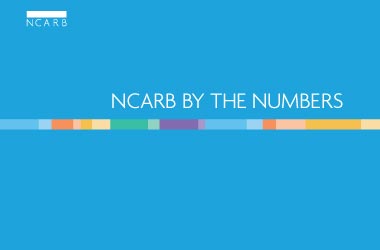
NCARB BY THE NUMBERS
Each year, our NCARB by the Numbers publication features the latest statistics on the path to licensure.

Did you know?
In 2012, NCARB held its first Intern Think Tank (later renamed to the Think Tank), which was comprised entirely of licensure candidates. NCARB uses the Think Tank to gain feedback and insights on licensure programs.
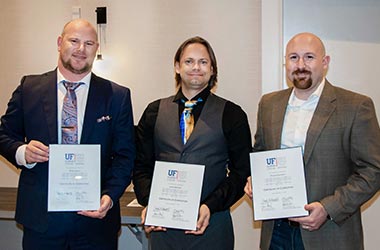
Did you know?
The first IPAL students successfully graduated in 2018, earning licenses shortly after graduation.
2015
NCARB’s new Integrated Path to Architectural Licensure (IPAL) initiative—designed to help students complete education, experience, and examination requirements concurrently—launches, accepting its first programs.
2016
The IDP becomes the Architectural Experience Program (AXP). ARE 5.0 launches.
"Streamlining the IDP requirements will reduce complexities while ensuring that intern architects still acquire the comprehensive experience that is essential for competent practice, and result in a program that is both justifiable and defensible."
2017
A new mutual recognition arrangement between the United States, Australia, and New Zealand is launched.
2019
NCARB celebrates 100 years of facilitating licensure.
VIDEO: CELEBRATING A CENTURY OF NCARB
Join us as we look back on the challenges and accomplishments of our 100-year history.
